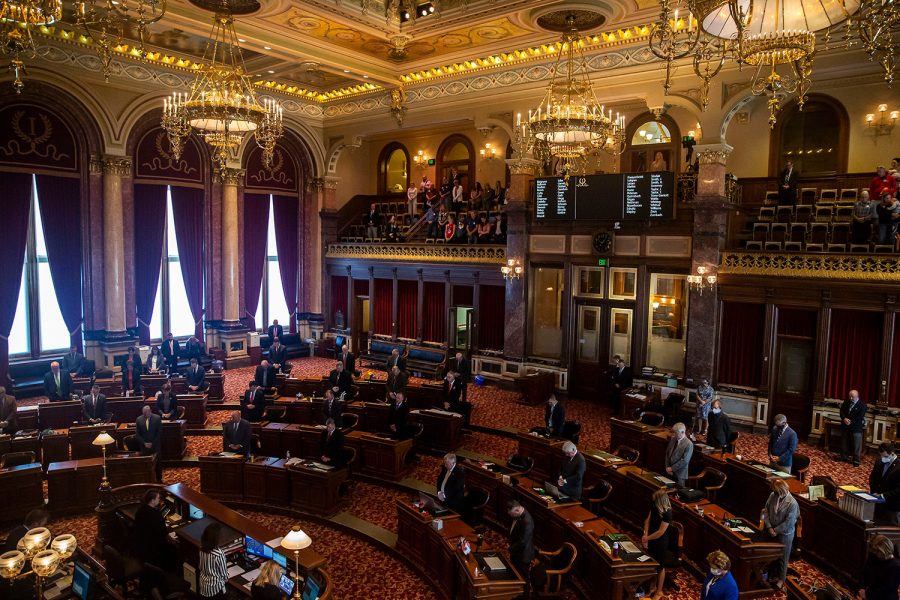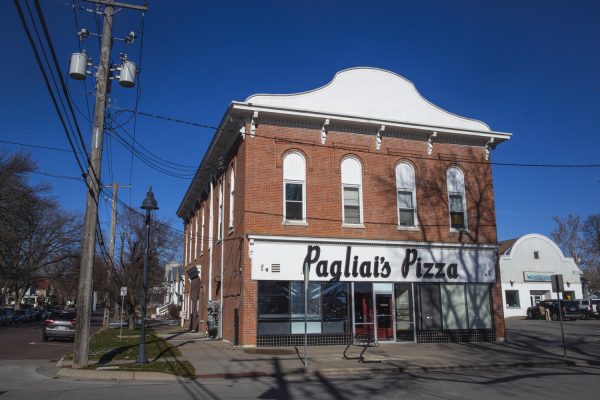Iowa Senate rejects first legislative and congressional maps
Republicans in the Iowa Senate said congressional and legislative maps could be improved, but Democrats said they satisfied Iowa Code.
Kelsey Kremer/The Register / USA
The Iowa Senate gavels in and begins a special session on redistricting maps on Tuesday, Oct. 5, 2021, at the Iowa State Capitol in Des Moines.
October 5, 2021
Republicans in the Iowa Senate voted down the first set of congressional and legislative maps proposed by the Iowa Legislative Services Agency, requiring the nonpartisan agency to return to the drawing board for another set of maps.
The Senate failed to approve the maps in a 18-32 party-line vote.
Lawmakers gathered at the Statehouse on Tuesday for a special session on redistricting.
The redistricting bill, SSB 1277, was brought before the Senate State Government Committee at 11:05 a.m., where the committee chair Sen. Roby Smith, R-Davenport, moved that the bill be approved without recommendation to the full Senate.
In the Senate, Smith argued that the plan can be improved in terms of compactness and population.
Senate Majority Leader Sen. Jack Whitver, R-Ankeny, echoed those comments in a written statement.
“Iowa has a good redistricting process and by requesting a second map, the Senate has continued to follow that process today,” he wrote. “Senate Republicans believe LSA can improve the compactness and population deviation of several districts by developing a second redistricting plan.”
Senate Minority Leader Sen. Zach Wahls, D-Coralville, said in a press call that not all members of his caucus thought the plan was good for them, but that they voted for the maps because they met the redistricting requirements.
“We’re not supposed to be voting on this plan based on whether or not it’s good or bad for incumbent legislators,” Wahls said. “We’re supposed to be voting on whether or not this plan met the statutory and constitutional requirements of population variance, compactness, etc.”
Sen. Kevin Kinney, D-Oxford, said in an interview with The Daily Iowan that his district would change quite a bit itself if the plan was approved, but that he felt it was a fair process.
“What I see is, there’s so many people that are moving away from rural Iowa that districts are going to be changing dramatically and shifting more to urban areas,” Kinney said.
Two Democrats, Sen. Pam Jochum, D-Dubuque, and Sen. Tony Bisignano, D-Des Moines, rose in support of the maps before it was voted down.
“The maps before us satisfy the Iowa law and the Iowa constitution,” Jochum said on the floor. “To those Republicans in this room who may have some concerns, this map is fair, it’s independent, it does not give an advantage of one party over the other.”
Bisignano said, if the second map is rejected, the legislature could go down a path of partisan redistricting, against the reputation of nonpartisanship redistrict that Iowa touts.
After the second plan is drawn up, legislators again will have to vote yes or no, without making any amendments to the map. If the second plan is voted down, a third set of maps will be drawn, and in that case legislators could make amendments — this has never happened in Iowa’s history.
RELATED: Special redistricting session approaches, elected officials tout Iowa’s process
Because the Senate voted the bill down, the House did not have a chance to debate the first set of maps.
“As I have stated previously, I believe these maps to be fair maps for Iowa,” Speaker of the House Pat Grassley, R-New Hartford said in a prepared statement. “However, I don’t believe the Senate’s concerns with compactness and population deviation are unwarranted. I am hopeful that LSA will produce a map that improves upon the Senate’s concerns and meets all of the other criteria for a fair map outlined in Iowa Code.”
Grassley said requesting a second map isn’t unprecedented and the legislature is still following Iowa’s gold standard.
“We shouldn’t be where we are now,” said House Minority Leader Rep. Jennifer Konfrst, D-Windsor Height, in a press call with Wahls. “But we certainly shouldn’t be voting down map two, because it will also be fair, it will also be drawn in accordance to Iowa Code and it will also be the most representative opportunity we have for Iowans to be able to choose their leaders.”
Wahls said his biggest concern was that partisan amendments could be made to the third map, but added that a lot has to happen between now and then for that to happen.
In an interview with the DI, Rep. Bobby Kaufmann, R-Wilton, said the argument that the current maps cannot be improved is ridiculous. Kaufmann said he hopes map two is good and that the legislature could move on, but that, “in no universe is going to map three a deviation from the gold standard.”
The Iowa Legislative Services Agency is a nonpartisan group that provides committee staffing, legal drafting, and budgeting services to the General Assembly. When drawing the maps, it cannot consider the addresses of incumbents, voter registration data, previous election results, or demographic information other than the population.
They will have 35 days to draw new maps. The legislature must approve a set of maps by Dec. 1, per the Iowa Supreme Court.
As previously reported by the DI, according to October voter registration numbers from the Secretary of State’s office, if this set of maps had been approved, Republicans would maintain a majority in the 4th Congressional District and have a slight majority in the 2nd Congressional District. Democrats would have a slight majority in the 3rd district, and in the first district registered Democrats would have a 61,000 lead over registered Republicans.














